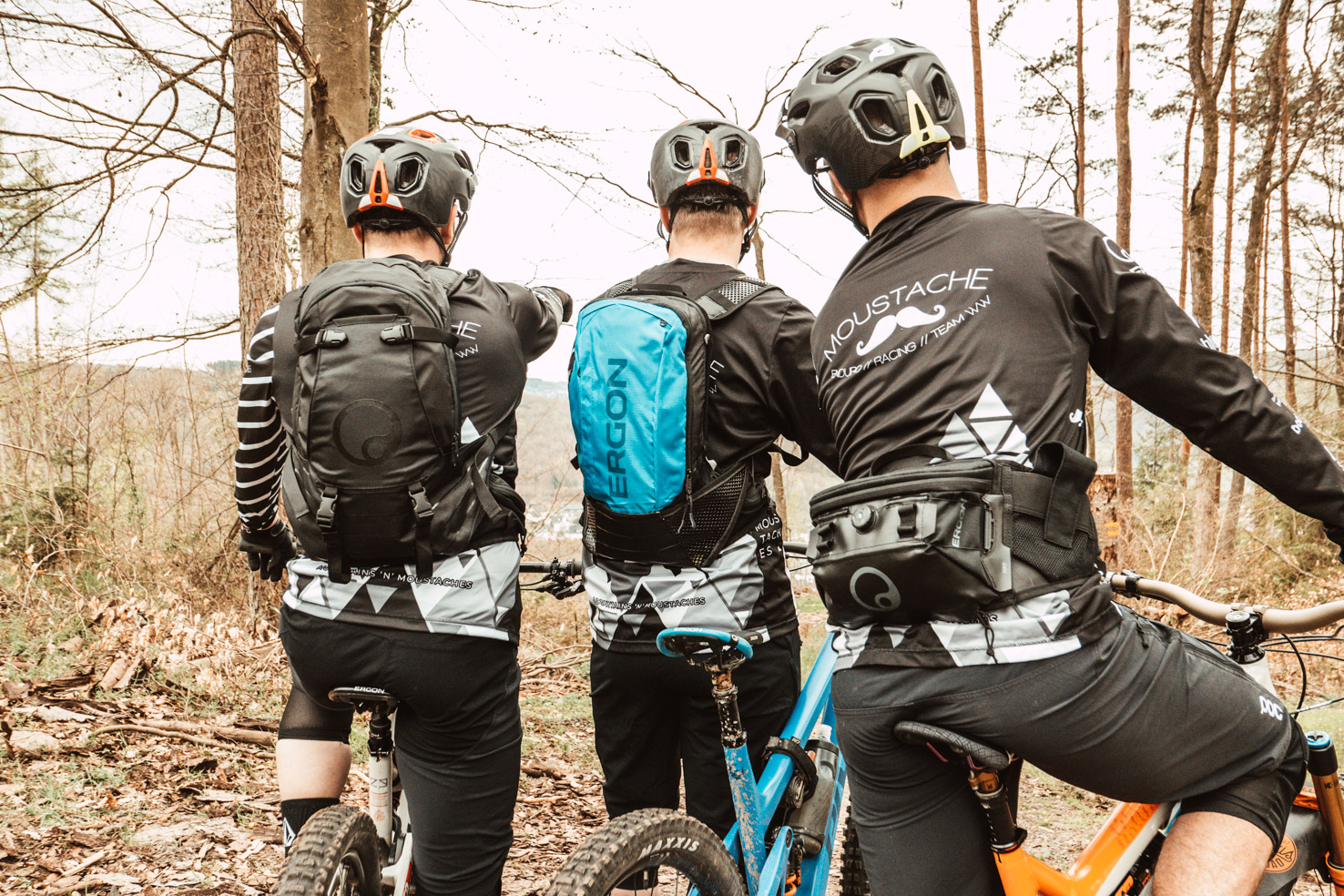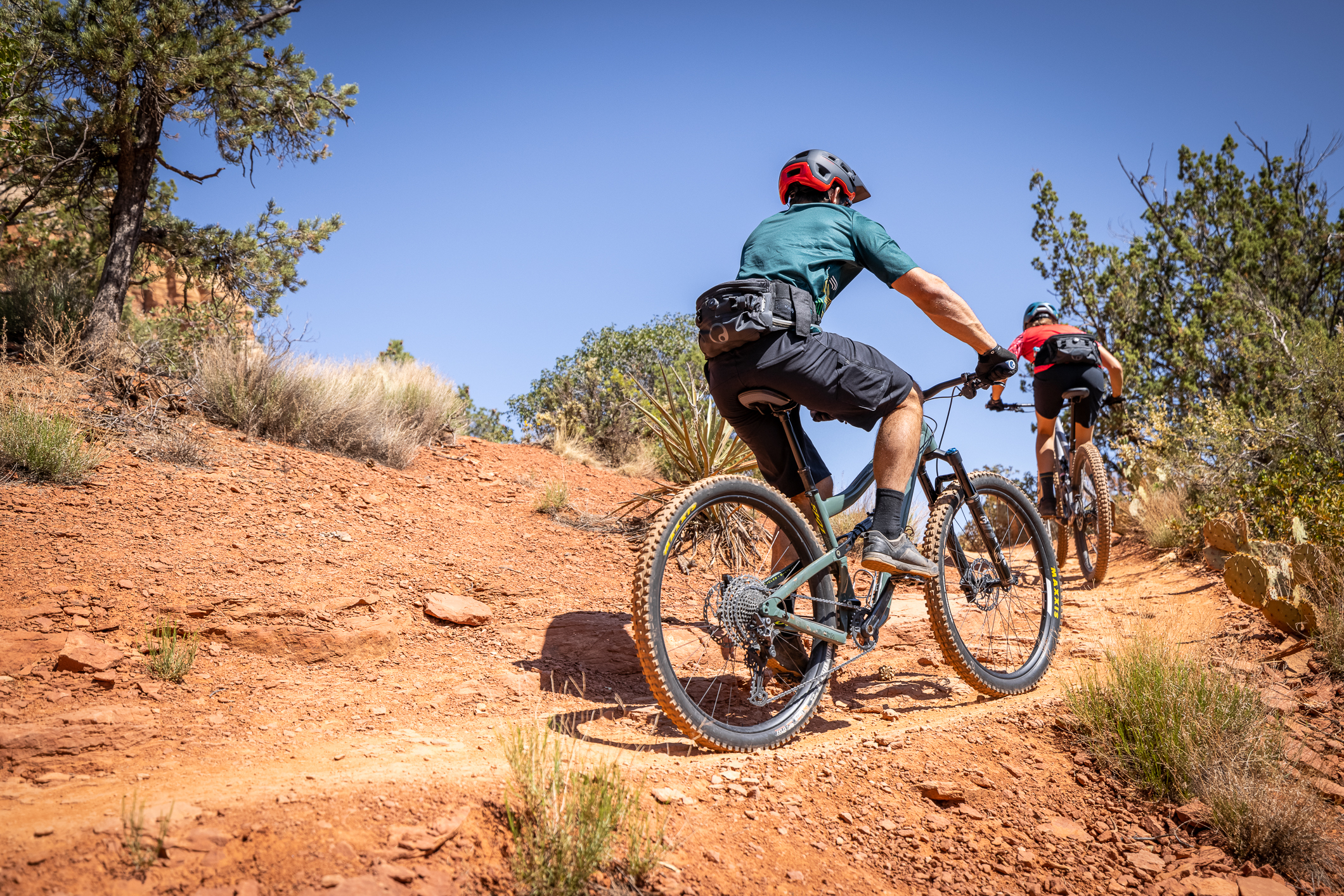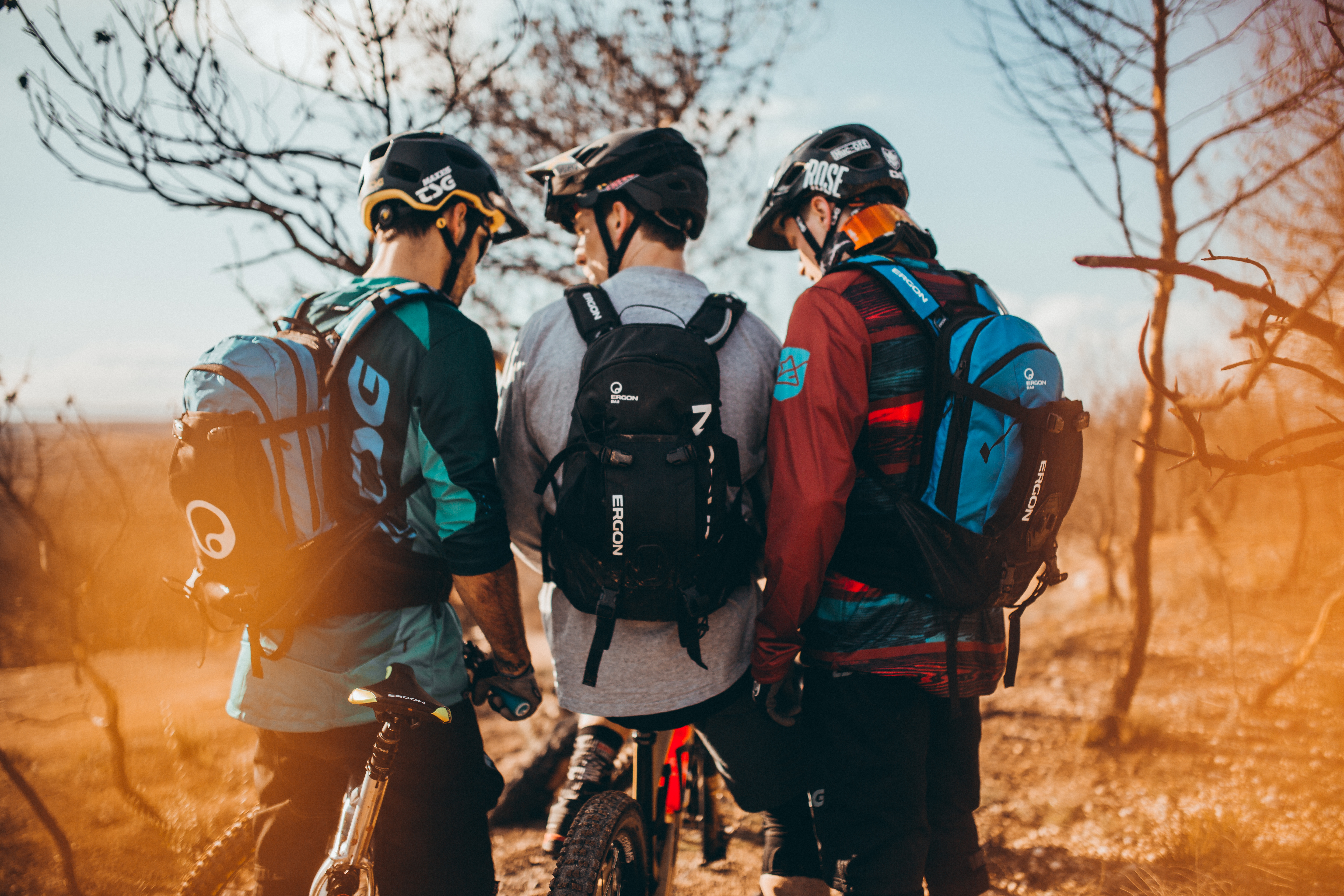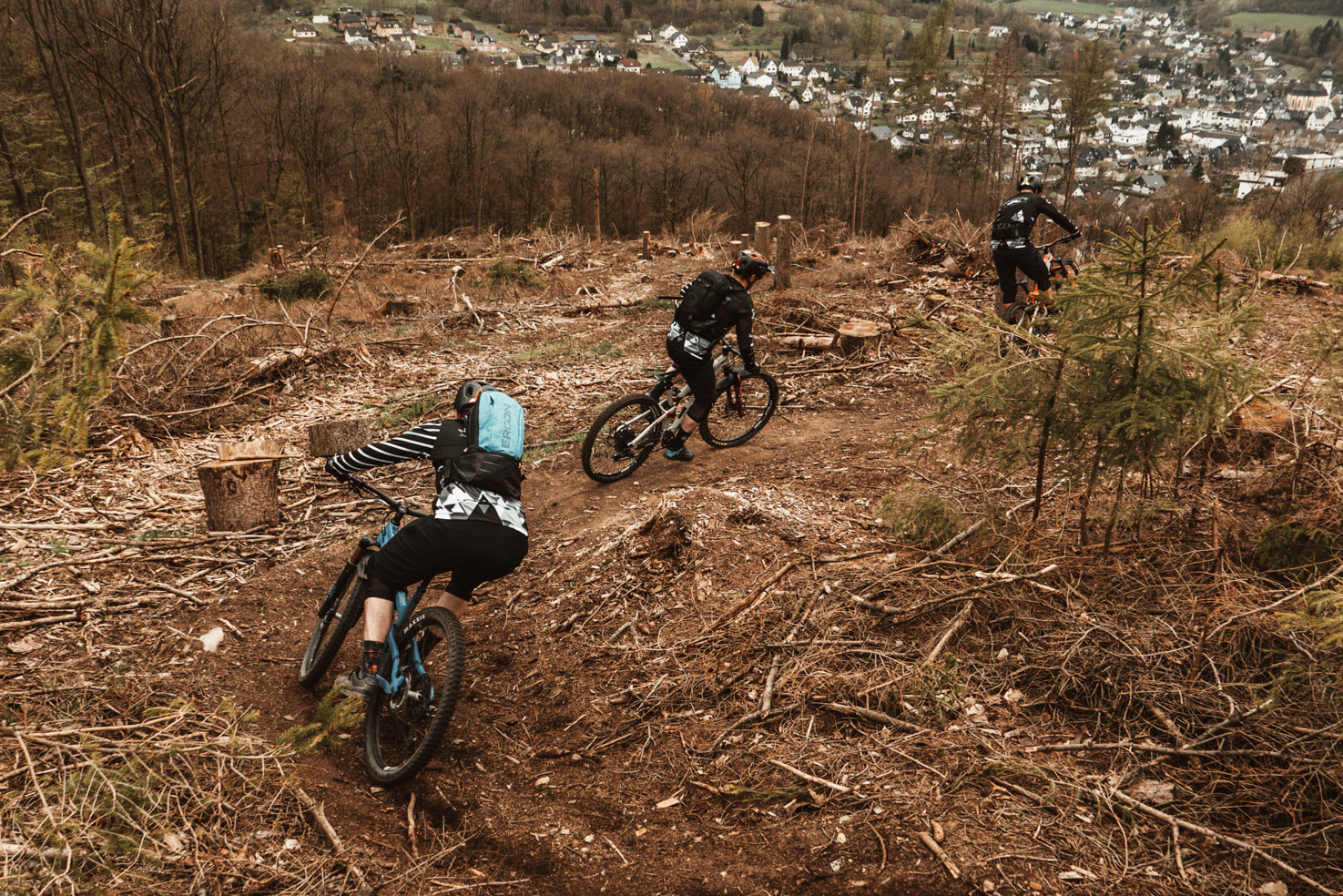Hip Bag or Backpack – Which is Better for You?

Hip bag or backpack? Opinions in the MTB scene are divided. For some, it's a revelation, for others, an absolute no. While the Ergon downhill faction disagrees, our author is undecided. A controversial discussion.
MTB Backpack or Hip Bag
Until recently, the bike backpack was a must-have for mountain bikers. However, a new means of carry has now spread among bikers – the hip bag. For some, it may feel liberating to bike without shoulder straps, for others, it's a breach of style. Somehow understandable, because (the author was born in the mid-1960s) it was a fanny pack that clung like an anxious koala to the midriff of the 90’s tourist trying to cover the sunburned skin between their t-shirt and the overly tight Arena swim briefs. Admittedly, modern MTB hip bags are worn on the lower back rather than the belly, but there’s stills that lingering image that can’t be unseen.
As is often the case in life – you get used to everything eventually, even hip bags on otherwise cool mountain bikers. And then suddenly, all the advantages come to mind. Especially on short rides or after-work trail laps, the trendy bags are perfect, as they offer enough space for a wind jacket, multitool, mini pump, cartridge, energy bar, car keys, and phone. Many models even allow for a hydration bladder, such as the BA Hip Pack from Ergon, which has a special 1.5-liter hydration bladder with a drinking tube available with the BH150. If you forgo the hydration system because you have a bottle cages on your mountain bike or prefer water bottles, you can easily fit up to four liters of gear in the main compartment of the Ergon bag. However, you should be careful not to overstuff the hip bag, as carrying more than 8 lbs can become uncomfortable on the hips. For those who want to carry less, the BA Hip Pack has another very useful feature – a twist lock that allows the bag to be quickly compressed with one hand, so the contents don't rattle around wildly inside the bag, especially on technical descents. Speaking of wild and technical – the BA Hip Pack also has straps to attach knee and elbow protectors under the bag, for a comfortable ride home from a bike park session.

More Freedom of Movement
Switching from a backpack to a hip bag can be an eye-opener. At first, it gives a relieving feeling because you have more freedom of movement and don't feel the pressure of the straps on your shoulders. Additionally, the spine is relieved, the weight is distributed to the hips, and brought closer to the body's center of gravity. A significant plus in mobility and balance lets you navigate roots and rocky trails with ease. The wide, ventilated hip belt, which can also be tightened with one hand, ensures a perfect fit and provides a second compression option. It also has a pocket for your phone. With its ergonomically padded back panel, the bag ensures a stable, ergonomic fit in every riding situation – even in challenging terrain. Another advantage is the unrestricted accessibility of the compartments, as you don't have to take off the bag like a backpack to get to the precious cargo. Simply slide it from back to front, and you can quickly rummage through its contents.
But while you're still beaming with happiness and rummaging contentedly in your hip bag, a sudden change in weather can cause a change in plans. Because hip bags usually don't have much room for spare clothes. If you're lucky, you might fit a thin wind or rain jacket, but that's it. And suddenly, the old MTB backpack comes back into focus.

Everything Important on Board
The advantage is clear. With a capacity of around 10 to 20 liters, the medium-sized daypacks, such as the BX2 Evo and BX3 Evo, as well as the BA2 and BA3 from Ergon, clearly have the edge over the smaller hip bag on extended mountain bike adventures. You can fit everything you’ll need to protect yourself from nasty surprises in the mountains or in rough terrain far from civilization: phone, food, pump, cartridges, tools, functional clothing, first aid kit, and in many cases, such as with the BA2 and BA3, even a spine/back protector. Additionally, load distribution is generally better in a backpack than in a hip bag.
To manage all this gear, Ergon backpacks have top-organized pockets and compartments. This way, you always have your phone, tools, spare tube, and first aid kit safely stowed and immediately accessible. An extra compartment on the back provides space for the BP100 back protector and the BH300 hydration bladder – the right hydration system for longer rides when you want to take more fluids and don't plan to carry an additional water bottle. Additionally, these two models are also equipped with a compartment for half-shell and full-face helmets, which particularly appeals to enduro riders who like to carry both styles of helmets.

Perfect Fit
When it comes to comfort, Ergon backpacks don't stray from their cuddly diminutive hip bags. The multi-award-winning, four-way adjustable carrying system with the ergonomic back panel can be easily and precisely adjusted to any back length from XS to XL. The patented load compression principle "Adaptive Carrier System" ensures a perfect fit, allowing the backpack to be ergonomically adjusted to the anatomical requirements of each rider. With the help of the flexible aluminum form rail, the padded back panel also fits perfectly to every body contour. The self-adjusting shoulder straps are also flexible and adapt optimally to the rider’s body shape. The wide hip belt can, of course, be shortened to the desired length, just like the BA Hip Pack. The carrying system is complemented by a stabilizing chest strap that provides additional support on technical descents.
For those who still find a backpack too large and a hip pack offering too little protection, the Ergon BP1 Protect is recommended. This minimalist backpack bridges the gap between a protector backpack and a pure back protector – for those who are actually looking for spinal protection for the bike park but don't want to do without tools and a hydration bladder or wind jacket. So small that it can even be worn under a jersey.

Conclusion
The question of whether to use a backpack or a hip bag is not so easily answered, so we have summarized the most important advantages and disadvantages of both systems for you.
Advantages
| Hip Bag | Backpack |
|
|
|
|
|
|
|
|
|
|
Disadvantages
| Hip Bag | Backpack |
|
|
|
|
|
|
|
|
|
|
|
|
This topic is also hotly debated at Ergon – here are the opinions of our two gravity dudes Alex "Bränschi" Brantsch and Sascha Bamberg alias "Bam Hill":
Alex Brantsch / Pro Hip Bag
The hip bag is my first choice for short and longer day tours. I always have all the tools with me, and in addition, at least with our BA Hip Pack, there is the possibility to carry things like knee pads, rain jacket, etc., with the carrying straps below the pack. The individual compartments always allow me to keep an overview and get to everything I need with one hand. Since the hip pack is smaller on the back than a backpack, you sweat less. I also particularly like the hip bag for gravel biking because of the lower weight and smaller contact area. The special strap fastening system is not only there to keep the hip pack stable when riding downhill. When I loosen it with one hand after a wild ride, it offers me more comfort and less contact with the back, which in turn makes me sweat less.

Bam Hill / Pro Backpack
The backpack, especially the BA2 and BA3, is my first choice to always have the most important gear, such as tools, jacket, camera, food, and drink, with me on the trail. Compared to the hip pack, I can even fit a large SLR camera in the BA2 or, as with the BA2 and BA3 Protect, a second e-bike battery, and the weight is evenly distributed on the back over the shoulders and hips. The best part: A protector can be integrated into the backpack, which protects my spine in case of falls, fits comfortably to the back, and prevents sharp objects from becoming uncomfortable. With their four-way adjustable back length and adjustable shoulder straps, Ergon backpacks can be perfectly adjusted to any back, whether male or female, thick or thin, tall or short.
